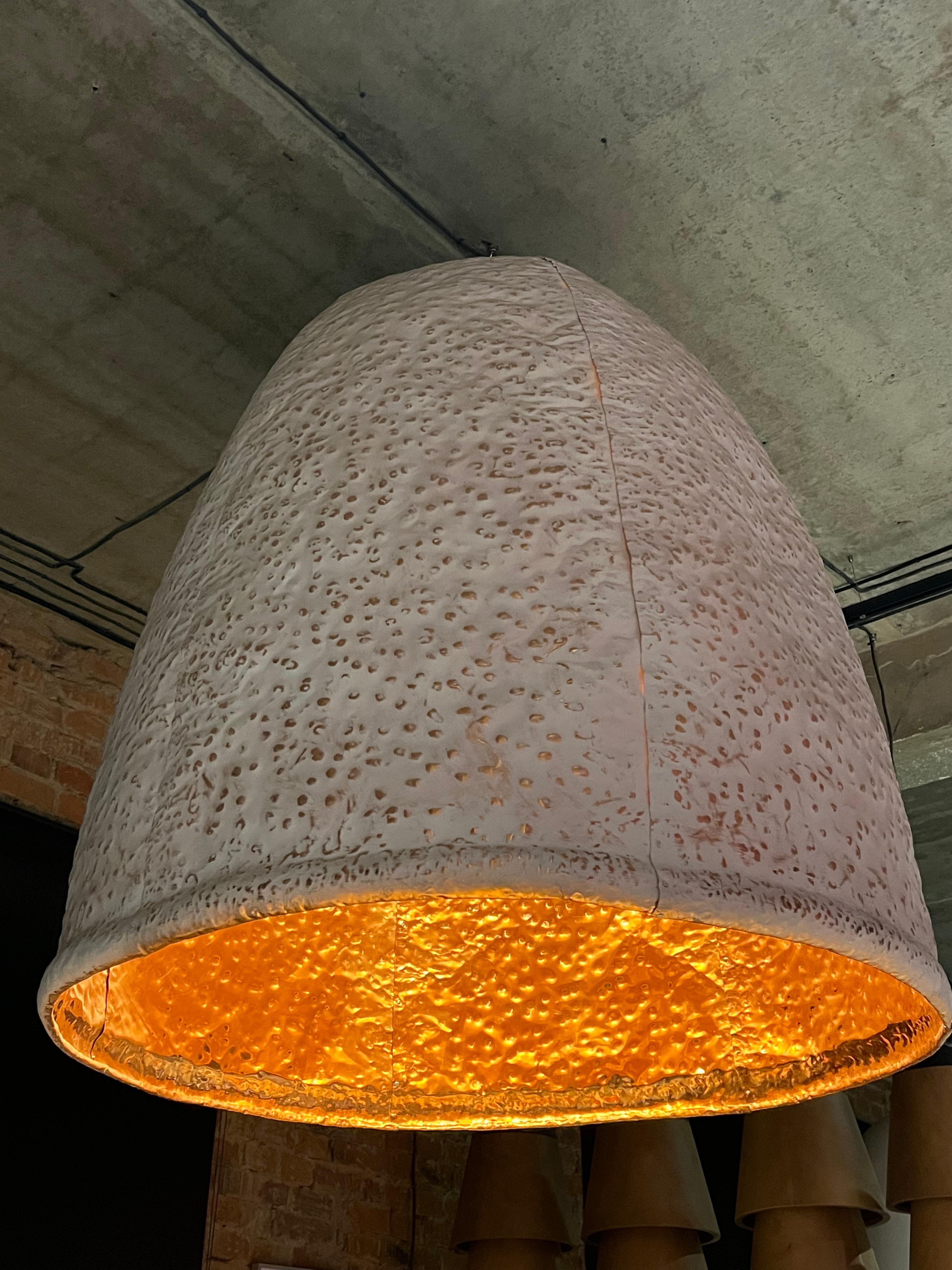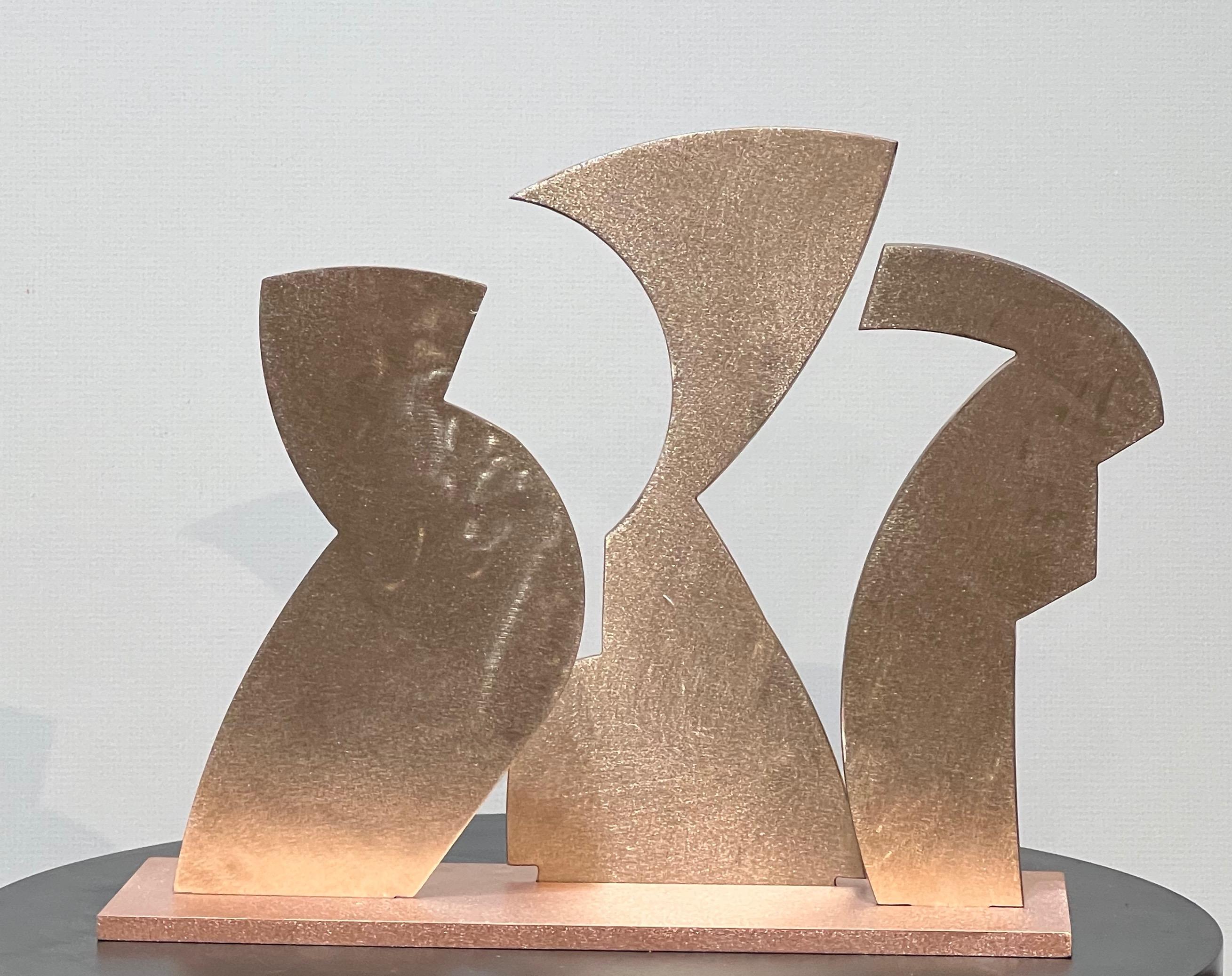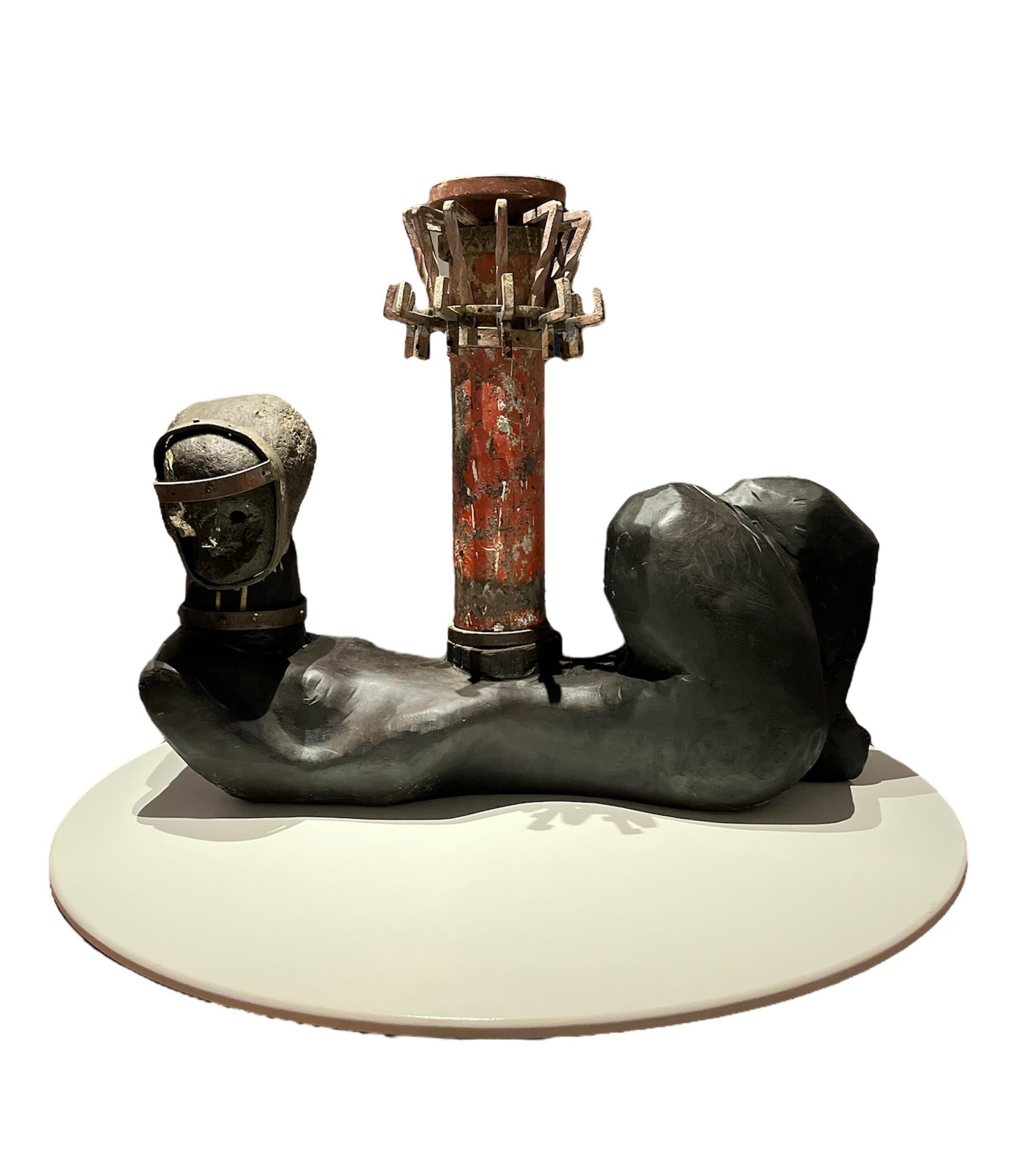Items Similar to Israeli Modernist Arts & Crafts Copper Lion Plaque Bezalel Schatz Yaad Studio
Want more images or videos?
Request additional images or videos from the seller
1 of 10
Israeli Modernist Arts & Crafts Copper Lion Plaque Bezalel Schatz Yaad Studioc.1960s
c.1960s
About the Item
Hand made in israel handwrought tray, platter in Silver plated copper modernist tray, engraving and hammer work, with a whimsical mod lion and design decorations. From the YAAD workshop of Bezalel Schatz, son of Boris Schatz. silver plating has been intentionally rubbed off.
Schatz lived in Israel, New York, and Northern California where he was part of the Big Sur artists'/writers' colony that included San Francisco sculptor Benny Bufano, author Henry Miller, and his sister Zahara Schatz.
Zahara and Bezalel rejected their father's predilection for Romantic Classicism and his dogged development of a Jewish Eretz Israel style in favor of a European-American modernism. Bezalel (nicknamed “Lilik”) Schatz was an Israeli artist, son of Boris Schatz, founder of the Bezalel School of Arts and Crafts in Jerusalem.
Born in 1912 to Boris Schatz, and his wife Olga, an art critic. From an early age, he demonstrated considerable talent for gymnastics and music, but especially for art. He grew up in a home in which artists were a constant presence, he was introduced to Israel’s most prominent leaders, and the first public exhibition of his artwork coincided with his Bar Mitzvah celebration. He attended the Gymnasia in Jerusalem and at age 14 completed his studies at the Bezalel School.
In 1930, Bezalel joined his father on a fundraising tour of Europe and the United States, where they also exhibited their artwork and that of Bezalel students. Following his father’s death in 1932, Bezalel left Israel for a period of about two decades. He spent the first four years studying at the Grand Chaumiere Academy in Paris. There, given the fairly conservative artistic views he had acquired at home and school – where modernism was denounced – he had to pave his own way as an artist among his peers.
Between 1937 and 1951, Bezalel resided in the U.S. Near the end of WWII, he worked in a California shipyard, and it was there he met his future wife, Louise. He was also introduced to the novelist Henry Miller in California, and their friendship blossomed into a creative collaboration. The artist May Ray recorded his observations about the two, noting that “I have never encountered such smooth cooperation…” Bezalel produced silkscreen prints for Miller’s novel, Into the Night Life, an innovation for both the art and publishing worlds. In Florence, New Mexico, New York, San Francisco, and other locations, Bezalel exhibited his own work and participated in group shows with some of the greatest artists of his era – Pablo Picasso, Henri Matisse, Marc Chagall, and Oskar Kokoschka.
Bezalel and Louise married in 1948 and moved to Israel three years later, taking residence in the Schatz house in Jerusalem. Despite his long absence from Israel and his conceptual conflicts with artists there, Bezalel mounted several exhibitions and represented his native country abroad – in Germany and at Venice’s 1954 Biennale, for example. Together with Louise Schatz and his sister, Zahara Schatz, he established the arts and crafts workshop, “Yad.” Handmade modernist folk art objects created there today are displayed and sold in a small building on the grounds of the family home on Bezalel Street in Jerusalem. When the Ein Hod artists’ village was founded in 1953, Bezalel and Louise moved to a home designed for them there by Israeli architect David Reznik. The couple melded easily into the village’s Bohemian artistic life, which resembled the lifestyle they had adopted in California.
Bezalel was an easy-going, congenial man of whom Henry Miller remarked, “Bezalel is an incorrigible optimist, the greatest optimist I ever met.” After his return to Israel, Bezalel’s most pleasurable moments were in the company of his small family and most intimate friends. He also continued to correspond with his friends in the U.S. He refrained from expressing his intellectual insights, either verbally or in writing, and never attempted to justify his work in any way. He was a productive post modernist artist and craftsman – vigorous, sensitive, and curious – and he contributed significantly to Israel’s aesthetic environment and art. His inspiration flowed from many different sources, from primitive tribes, to Biblical tales, Western art, the nature and history of Israel, and the symbols of his homeland that had also inspired his father.
Bezalel’s art work exemplified many different techniques. His early works adhered to the realistic/academic style he learned at the Bezalel art school. Later, his development was influenced by abstract art. His works included sketches, prints, oil painting reliefs, hand made copper engravings, applied art, graphic art, ceramic, and Judaica. In the last decade of his life, his major artistic endeavor was mural design. Among his public works were artwork for ships owned by the Israeli company Zim, the gates at the entrance to the President’s Residence in Jerusalem, and a fence in the courtyard area of the Western Wall.
Bezalel died in Jerusalem in 1978.
- Attributed to:Bezalel Schatz (1912-1983)
- Creation Year:c.1960s
- Dimensions:Height: 7.5 in (19.05 cm)Width: 7.5 in (19.05 cm)
- Medium:
- Movement & Style:
- Period:
- Condition:
- Gallery Location:Surfside, FL
- Reference Number:1stDibs: LU38214258422
About the Seller
4.9
Platinum Seller
These expertly vetted sellers are 1stDibs' most experienced sellers and are rated highest by our customers.
Established in 1995
1stDibs seller since 2014
1,548 sales on 1stDibs
Typical response time: 1 hour
- ShippingRetrieving quote...Ships From: Surfside, FL
- Return PolicyA return for this item may be initiated within 3 days of delivery.
More From This SellerView All
- Helen Shirk Sculpture Hand Crafted Studio Vessel, Copper Patina, Colored PencilsLocated in Surfside, FLTitle: Red Pod, CV110V, San Diego, 1997 Fabricated, hammered copper, colored pencils, patina. This is not signed. It bears a label on the interior and the artist has kindly confirmed the attribution to me. Helen Shirk...Category
1990s American Modern Abstract Sculptures
MaterialsCopper
- Mexican Art Abstract Brutalist Biomorphic Bronze Sculpture Mathias GoeritzBy Mathias GoeritzLocated in Surfside, FLMathias Goeritz (German Mexican, 1915-1990) Bronze sculpture Signed and numbered Dimensions: (approximate) Height: 10 inches, Width: 4 inches, Depth: 2 inches. This is a cast bronze sculpture in an amorphous figure shape, quite heavy. Reminiscent of the biomorphic sculpture of Hans Jean Arp. This came from an estate and bears his signature It is not dated. there is no accompanying documentation. it is priced accordingly. Werner Mathias Goeritz Brunner (Danzig, Germany, April 4th, 1915/ now Gdansk, Poland – Mexico City, Mexico; August 4th, 1990). Mathias Goeritz has had several gallery and museum exhibitions, including at the Museo Nacional Centro de Arte Reina Sofía and at the Museo Experimental El Eco. Numerous works by the artist have been sold at auction, including 'MENSAJE' sold at Sotheby's New York 'Latin American Modern Art' in 2015 for $466,000. There have been Several articles about Mathias Goeritz, including 'LACMA remaps Latin America' written by Suzanne Muchnic for the Los Angeles Times. Painter, sculptor and Mexican architect associated with the trend of constructive abstraction. He studied medicine at the University of Berlin, but this only lasted a year. The concerns of the young student were aesthetic in nature so he he studied figurative drawing at the Berlin Charlottenburg School of Art. Some of his friends and colleagues were the sculptor Ernst Barlach, painter George Grosz and draughtsman Kaethe Kollwitz. Goeritz studied philosophy and history of art, discipline in which earned a doctorate. He travelled in France, Switzerland, Czechoslovakia, Poland, Austria and Italy, among other countries. It is known that he left Germany to live in Tetuan, Morocco in 1941 and then Granada, Spain in 1945. In 1946 he had a large exhibition in the Sala Clan in Madrid under the pseudonym "Mago". Two years later, living in Santilla del Mar, Spain he was a founder of the Escuela de Altamira. The following year he married Marianne Gast, writer and his companion for more than fifteen years. In Spain followed his artistic work by important artists of the avant-garde. Of Jewish descent, he found refuge from the Second World War in Mexico where in 1949 he was invited by Ignacio Diaz Morales to be a part of the faculty of the School of Architecture at the Universidad de Jalisco. In 1953 he wrote the "Manifiesto de la Arquitectura Emocional" (The Emotional Architecture Manifesto), where he points out that only achieving true emotions from architecture can it then be considered an art form. In Mexico he entered controversy with the artistic stablishment of that country; in an open letter, Diego Rivera and David Alfaro Siqueiros described him as "an impostor without the most insignificant talent and preparation" to be an artist. Despite this, in 1957 he was elected director of visual design of the National School of architecture This same year he founded the Museo del Eco in Mexico City. In 1961 Goeritz participated at the Galería Antonio Souza in a group exhibition, Los hartos, for which he published another manifesto. Other participants included Jose Luis Cuevas and Pedro Friedeberg, with whom he was instrumental in establishing abstraction and other modern trends in Mexico.His work is included in the Gelman Collection of modern and contemporary Mexican art based in Cuernavaca, Mexico. Established by Jacques and Natasha Gelman in 1943 as a private collection. it includes many iconic works by major Mexican Modernists including Frida Kahlo, Diego Rivera, David Alfaro Siqueiros, Leonora Carrington, Rufino Tamayo and Francisco Toledo, Lola Alvarez...Category
20th Century Modern Abstract Sculptures
MaterialsBronze
- Israeli Bronze Sculpture Lovers Embrace Abstract Modernist Ein Hod IsraelBy Gedalia Ben ZviLocated in Surfside, FLBronze sculpture signed in Hebrew and numbered from small edition of 6 BIOGRAPHY "I was born in Czechoslovakia in the year 1925, of traditional parents. I spent my youth partly in a little town on the Moravian border, and to a greater part in Bratislava, the capital of Slovakia. Having been attracted by the arts from early childhood on, I studied functional art at a school in Bratislava, as long as this was still possible under the Nuremberg Laws which, at that time, were also in force in Slovakia. In 1942 I was taken to a concentration camp in Poland and at the beginning of 1945 I succeeded in escaping together with a friend of mine. Until our liberation by the Russians we were hiding in the forests of Northern Poland. At the end of the War I found myself wandering about Europe, together with thousands of survivors from the Holocaust, until, in 1948 I came to Israel via the Camps of Cyprus. From 1954 onwards I have been a permanent resident of the Artists Village at Ein-Hod, together with my family. In the course of that time I studied and worked in most of the creative techniques of the arts. During various periods of my life at Ein-Hod I taught painting and handicraft at different schools. In 1965 I gave up teaching and have since devoted myself exclusively to pure art." Gedalia Ben Zvi. Exhibitions 1962-1963 Design Exhibition, Tel Aviv 1964 Middle East Fair, Tel Aviv 1965 Ceramic Mural for school in Kiryat Gat a the Housing Exhibition in Tel Aviv 1966 Israel Fair and Exhibition, Paris One man show, Ein Hod International Symposium on “Ceramics in Architecture” Tel Aviv Ceramic Museum Museum or Modern Arts, Heavy Museum of Acre 1968 Painters Israeliens dans I’Art de Gobelins, Jerusalem Ein Hod Artists Village - Tenths Year Anniversary Exhibition 1963, Artists: Zvi Aldouby, Marcel Janco, Rudi Lehmann, Moshe Mokady, Aviva Margalit Mambush, Yohanan Simon, Dov Feigin, Ovadia Alkara, Mark Tochilkin...Category
Mid-20th Century Modern Figurative Sculptures
MaterialsBronze
- The Test, Assembled Kinetic Modernist Sculpture Puzzle ConstructionBy William King (b.1925)Located in Surfside, FL"The Test," 1970 Aluminum sculpture in 5 parts. Artist's cipher and AP stamped into male figure, front, 20 5/16" x 12 1/2" x 6 5/7" (approx.) American sculptor King is most noted for his long-limbed figurative public art sculptures depicting people engaged in everyday activities such as reading or conversing. He created his busts and figures in a variety of materials, including clay, wood, metal, and textiles. William Dickey King was born in Jacksonville, Florida. As a boy, William made model airplanes and helped his father and older brother build furniture and boats. He came to New York, where he attended the Cooper Union and began selling his early sculptures even before he graduated. He later studied with the sculptor Milton Hebald and traveled to Italy on a Fulbright grant. Mr. King worked in clay, wood, bronze, vinyl, burlap and aluminum. He worked both big and small, from busts and toylike figures to large public art pieces depicting familiar human poses — a seated, cross-legged man reading; a Western couple (he in a cowboy hat, she in a long dress) holding hands; a tall man reaching down to tug along a recalcitrant little boy; a crowd of robotic-looking men walking in lock step. Mr. King’s work often reflected the times, taking on fashions and occasional politics. In the 1960s and 1970s, his work featuring African-American figures (including the activist Angela Davis, with hands cuffed behind her back) evoked his interest in civil rights. But for all its variation, what unified his work was a wry observer’s arched eyebrow, the pointed humor and witty rue of a fatalist. His figurative sculptures, often with long, spidery legs and an outlandishly skewed ratio of torso to appendages, use gestures and posture to suggest attitude and illustrate his own amusement with the unwieldiness of human physical equipment. His subjects included tennis players and gymnasts, dancers and musicians, and he managed to show appreciation of their physical gifts and comic delight at their contortions and costumery. His suit-wearing businessmen often appeared haughty or pompous; his other men could seem timid or perplexed or awkward. Oddly, or perhaps tellingly, he tended to depict women more reverentially, though in his portrayals of couples the fragility and tender comedy inherent in couplehood settled equally on both partners. His first solo exhibit took place in 1954 at the Alan Gallery in New York City. King was elected to the American Academy of Arts and Letters in 2003, and in 2007 the International Sculpture Center honored him with the Lifetime Achievement in Contemporary Sculpture Award. Mr. King’s work is in the collections of the Metropolitan Museum of Art, Guggenheim Museum, Whitney Museum and the Museum of Modern Art in New York and the Hirshorn Museum at the Smithsonian American Art Museum in Washington, among other places, and he had dozens of solo gallery shows in New York and elsewhere. Reviews of his exhibitions frequently began with the caveat that even though the work was funny, it was also serious, displaying superior technical skills, imaginative vision and the bolstering weight of a range of influences, from the ancient Etruscans to American folk art to 20th-century artists including Giacometti, Calder and Elie Nadelman. The New York Times critic Holland Cotter once described Mr. King’s sculpture as “comical-tragical-maniacal,” and “like Giacomettis conceived by John Cheever.”Category
1970s American Modern Figurative Sculptures
MaterialsMetal
- Brutalist Modern Abstract Bronze Sculpture Metropolis Manner of Louise NevelsonBy Abbott PattisonLocated in Surfside, FLA very heavy, massive bronze sculpture by an important Chicago sculptor. Signed and marked "Firenze" with "Fuse Marinelli". METROPOLIS. Seven abstract shapes on black marble base. 1...Category
20th Century Modern Abstract Sculptures
MaterialsMarble, Bronze
- Large Art Moderne Bronze Sculpture Esther Wertheimer Mother Baby Child Art DecoLocated in Surfside, FLEsther Wertheimer ( Polish, Canadian 1926 - 2016 ) Hand signed Wertheimer Dimensions: 14.5 X 8 X 5.75 in. This semi abstract figurative bronze scul...Category
20th Century Modern Figurative Sculptures
MaterialsMarble, Bronze
You May Also Like
- "SHELL" Sculptural Lamp 51" x 43" inch by Grigorii GorkovenkoBy Grigorii GorkovenkoLocated in Culver City, CA"SHELL" Sculptural Lamp 51" x 43" inch by Grigorii Gorkovenko MATERIAL: copper COLOR: matte white - natural One lampshade. Lampshade only. Wir...Category
21st Century and Contemporary Contemporary Figurative Sculptures
MaterialsCopper
- LaminateBy Kim SeungwooLocated in Palm Beach, FLKim Seungwoo is a contemporary Korean sculptor, based in Seoul, South Korea, famous for his sculptures made of coins.Category
2010s Contemporary Abstract Sculptures
MaterialsCopper, Steel
- Henge, sculpture by Kerry Green, copper, bronze, abstract, figures, metal sculptBy Kerry GreenLocated in Santa Fe, NMHenge, sculpture by Kerry Green, copper, bronze, abstract, figures, metal sculpture Since childhood, Kerry Green has always been creative; painting, drawing, sculpting, and sewing. Her family provided her with materials and encouraged her efforts. She literally grew up in her parents’ art galleries, and with them toured the U.S., Europe, Mexico, Japan, and New Zealand, seeing museums and visiting artists’ studios. Growing up in Arizona and New Mexico gave her the opportunity to explore the Native reservations there where she has made life-long friendships. Several of her very early influences were Dr. Harry Wood...Category
2010s Contemporary Abstract Sculptures
MaterialsBronze, Copper
- Laminate IIBy Kim SeungwooLocated in Palm Beach, FLKim Seungwoo is a contemporary Korean sculptor, based in Seoul, South Korea, famous for his sculptures made of coins.Category
2010s Abstract Geometric Abstract Sculptures
MaterialsCopper, Steel
- ORÍ GUERREIRA NA LUZ I, Figurative Sculpture. From the Series SculpturesLocated in Miami Beach, FLORÍ GUERREIRA NA LUZ I, 2021 - 2023 by José Ignacio Suarez Solis From the Series Sculptures Carving, assembling and painting (granite, wood, iron, acrylic, zinc plate and copper wire...Category
2010s Abstract Abstract Sculptures
MaterialsGranite, Copper, Iron, Wire
- ORÍ GUERREIRA NA LUZ II, Figurative Sculpture. From the Series SculpturesLocated in Miami Beach, FLORÍ GUERREIRA NA LUZ II, 2021 - 2023 by José Ignacio Suarez Solis From the Series Sculptures Carving, assembling and painting (granite, wood, iron, acrylic, zinc plate and copper wir...Category
2010s Abstract Abstract Sculptures
MaterialsGranite, Copper, Iron, Wire





